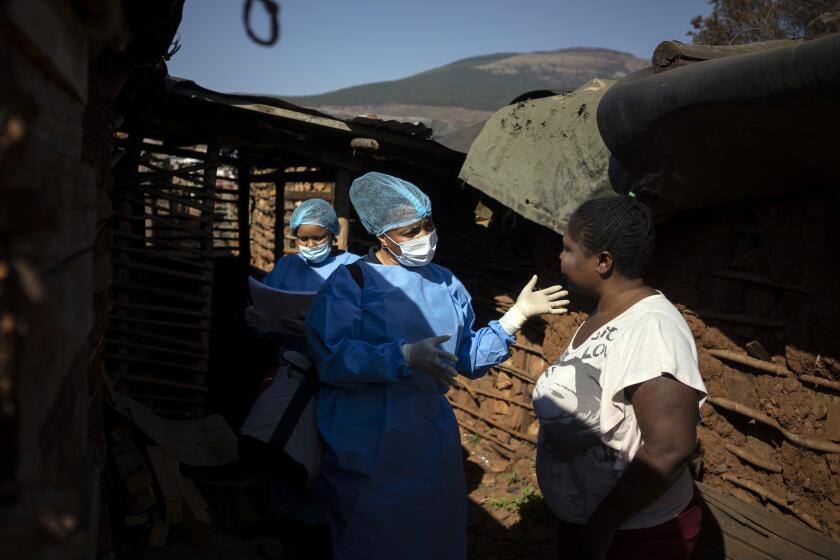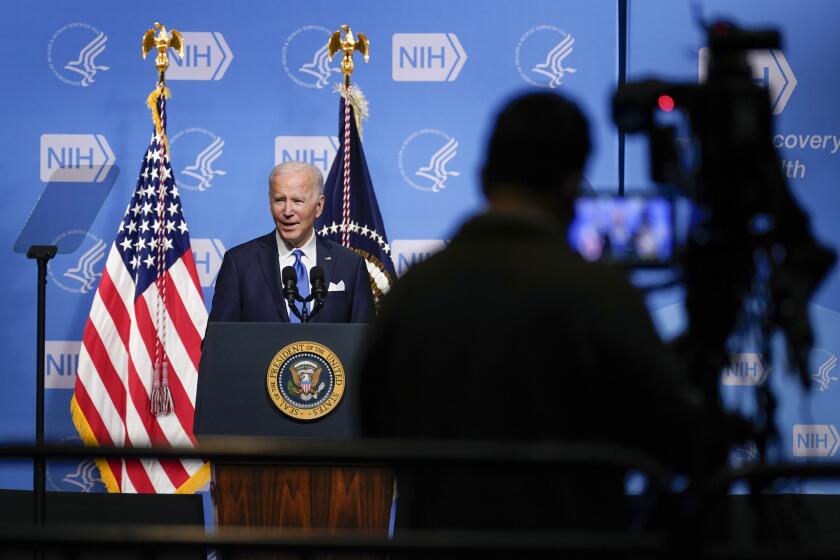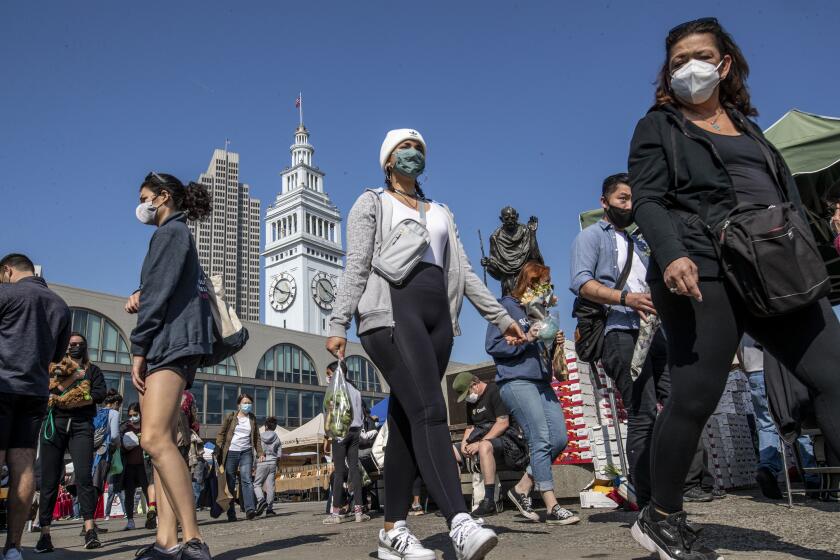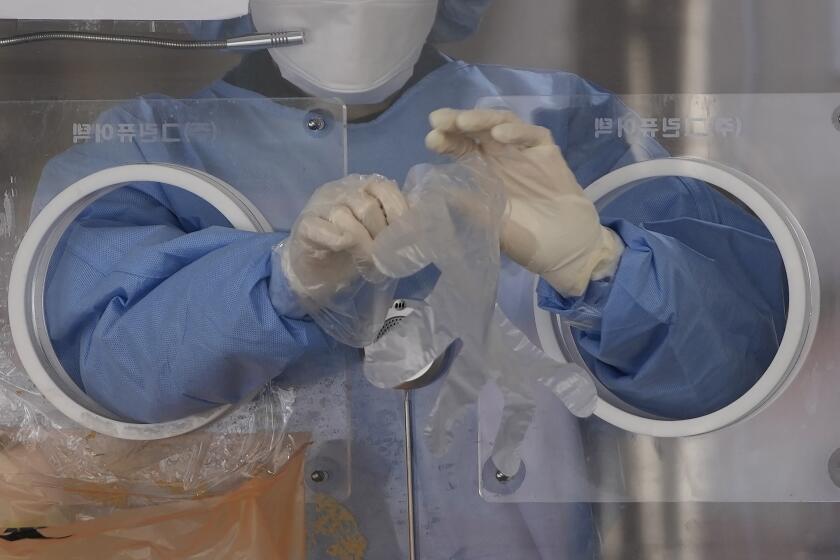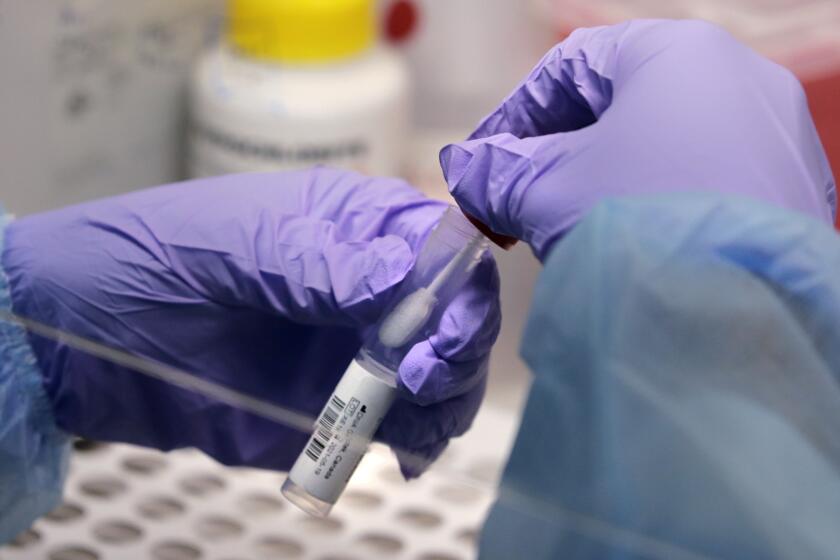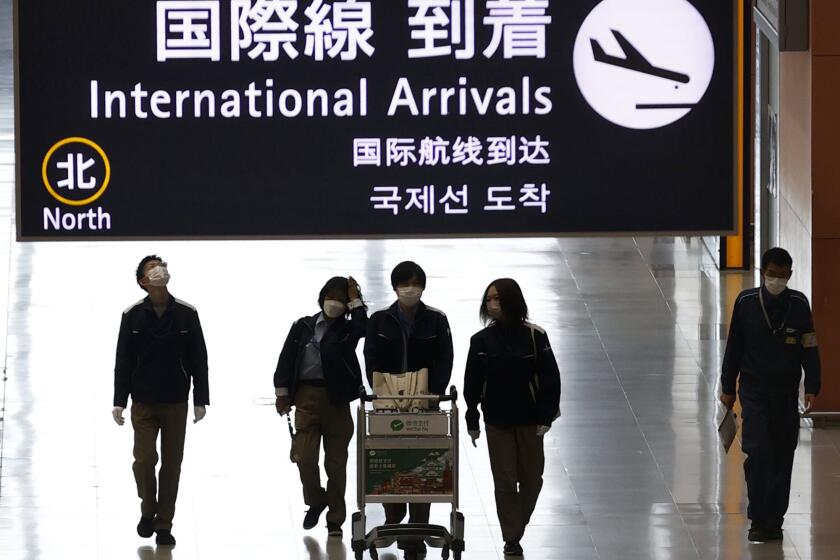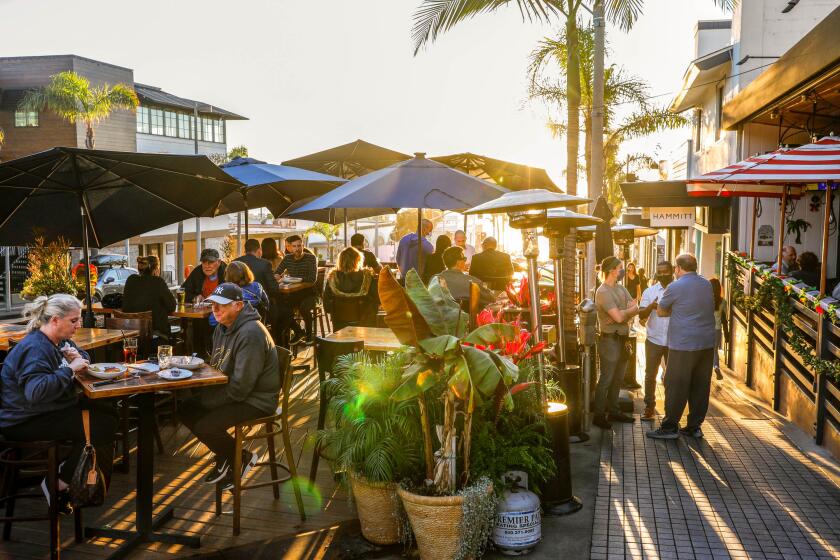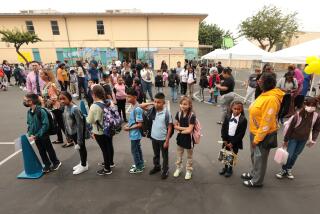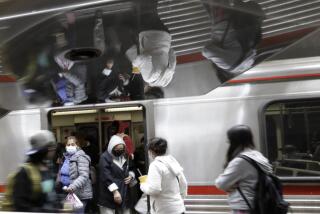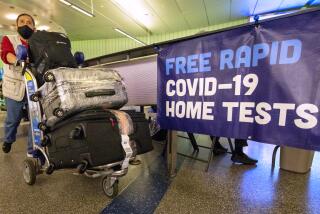L.A. County records first case of Omicron variant as officials urge more COVID-19 testing
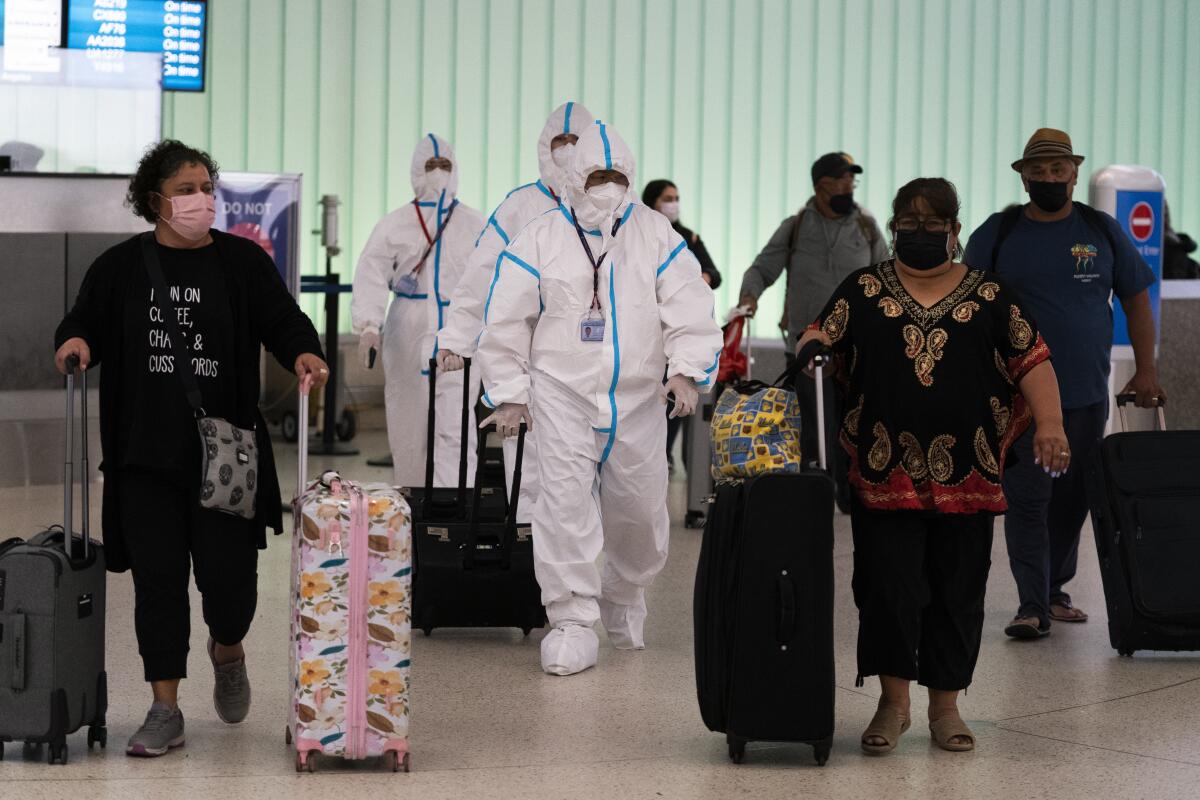
- Share via
Los Angeles County reported its first case of the heavily mutated Omicron variant of the coronavirus Thursday evening — a development that, while not unexpected, nevertheless underscores the need for residents to continue to take steps to protect themselves, public health officials said.
“Throughout the pandemic, we have always known there would be more mutations, resulting in the possibility of a more dangerous variant than the Delta variant,” county Public Health Director Barbara Ferrer said in a statement. “While we can’t know for certain the impact of Omicron at this time, the good news is that we already know how to reduce transmission and slow spread using both pharmaceutical and non-pharmaceutical interventions.”
The infection, county officials said, was most probably travel related, as the individual had returned after flying to South Africa via London on Nov. 22 — just days before Omicron’s detection was publicly announced and the World Health Organization officially declared it a “variant of concern.”
The adult individual, identified only as a fully vaccinated L.A. County resident, is “self-isolating, and their symptoms are improving without medical care,” the county said in a statement.
“A small number of close contacts in Los Angeles have been identified and, to date, all have tested negative and have no symptoms,” officials added.
The Omicron variant was probably incubated in a person with poorly controlled HIV who struggled to clear a coronavirus infection.
Confirmation of the variant in the nation’s most populous county came as officials urged residents to get tested for the coronavirus more frequently when it makes sense to do so — particularly if they plan to travel or gather with family or friends during the holiday season.
Increased testing has long been a centerpiece of both the local and federal response to the COVID-19 pandemic. Such screenings have grown even more important following the discovery of the new highly mutated strain.
L.A. County plans will instruct skilled nursing facilities to introduce more routine testing of residents and staff, “and to offer rapid testing for visitors that are entering any indoor spaces at these facilities,” Ferrer said Thursday.
In partnership with the state and U.S. Centers for Disease Control and Prevention, the county also will set up a free rapid testing site Friday for arriving passengers at the international terminal at Los Angeles International Airport.
“Testing remains essential. It’s an important tool in quickly detecting cases and allowing us, therefore, to reduce spread,” Ferrer said.
President Biden said Thursday that his plan for COVID-19 ‘pulls no punches.’
Expanded testing was also one of the primary pillars of a winter response plan President Biden unveiled earlier in the day.
Along with requiring insurance companies to reimburse people for the purchase of home tests, 50 million such tests are expected to be distributed to community health centers and rural clinics, where those without insurance can access them at no cost.
Ferrer welcomed those efforts, saying the cost — about $10 to $12 a pop — is prohibitive for some.
“So for people who don’t have those [financial] resources, it’s going to be super important that insurance covers it, and that for people who are uninsured or underinsured, that we make sure that there’s easy access,” she said during a briefing.
Rapid tests, which offer results in 15 minutes using a kit that can be taken anywhere, help people know if they’re essentially safe before heading to work or going to a social gathering, Ferrer said.
“It creates a lot of safety for you and it also creates safety for the rest of us,” she said.
A UC San Francisco lab that analyzes coronavirus test results is a big reason behind the quick identification of the Omicron variant in California.
The site at LAX, for instance, will also give those testing negative a kit they can use to test themselves again three to five days later, in line with CDC recommendations for international travelers coming to the U.S., regardless of vaccination status.
Those who test positive will be required to isolate, and their close contacts to quarantine. Testing upon arrival will be voluntary, and those who take the test will be able to get their results before leaving the airport.
But testing isn’t just for people who travel.
“We’re also recommending if you participated in gatherings or events over the holidays with large numbers of people, some of whom may be unvaccinated, you too ought to go and get tested,” Ferrer added.
Anyone who tests positive should stay isolated from others for at least 10 days from the date that the symptoms began, or when they tested positive if they don’t have symptoms.
Ferrer said L.A. County now has plentiful testing capacity, and “it’s very appropriate to use testing as another tool to prevent us from spreading infection. And yes, vaccinated people, certain vaccinated people, who have a known exposure or potential exposure should be getting tested.”
It also makes sense, Ferrer said, for older people to ask guests to test themselves with a rapid test before they enter their home.
“As we head into the winter holidays, we do know it makes sense for us to be more cautious. And given the emergence of a new variant of concern, taking sensible steps to limit our risk of being exposed or transmitting to others is just prudent,” she said.
“We should be cautious — as cautious as we can be — while we’re getting more information about Omicron,” but it’s also true that people should remain vigilant since Delta is still highly infectious.
Omicron’s impact on the COVID-19 pandemic will depend on a variety of factors that will take days to weeks for scientists to untangle.
Scientists are racing to get a better understanding of the Omicron variant, which burst onto the scene last week.
The strain has numerous mutations, including some that have sparked concern that it could be able to spread more easily or avoid some of the protective power of vaccines.
Ferrer offered the following suggestions for people wondering what to do as scientists learn more about the Omicron variant:
• People shouldn’t travel until they are fully vaccinated.
• All adults should get a booster shot if enough time has elapsed since they got their primary vaccination dose.
• Fully vaccinated people in high-risk groups, such as those who have weakened immune systems, are older or have significant underlying health conditions, may want to ask their healthcare provider whether they should delay travel plans until more is known about the new variant. People in this high-risk group should be “very, very careful.”
As expected, the Omicron coronavirus variant, first detected last month, has reached the U.S., with the first case found in California.
But fully vaccinated people who aren’t at high risk should still be aware that travel puts them at greater risk of viral exposure.
“When we have, at this point, really not a lot of information about a potential new threat, you may decide to just delay those plans until we do have more information, and we can feel pretty secure that we have prevention strategies at hand and we’re using them to protect each other from transmission of a new variant of concern,” Ferrer said.
Those who do plan to travel, she added, should “do it with a lot of caution and a lot of care.”
“Make sure you’re using either a good KN95 mask or you’re double masking; you’re being particularly careful about doing a lot of handwashing, keeping your distance wherever possible, avoiding those crowds wherever you can, because that will work no matter what — no matter what’s circulating. That will work to provide you with some protections,” she said.
As more countries detect cases of the Omicron variant, conferences and business gatherings are being canceled. U.S. travel hasn’t yet been curtailed.
Gatherings also are less risky if they’re held outdoors.
“This is the time, if you’re a higher-risk person, to be particularly careful about what you choose to do and where you choose to go,” Ferrer said.
Weekly coronavirus case numbers have recently been stable in Los Angeles County, as have COVID-19 hospitalizations.
Nonetheless, transmission across Southern California remains at substantial or high levels — the worst two levels of the CDC’s four-tier rubric — and Ferrer said she expects holiday travel and gatherings could lead to increased spread.
The next 10 to 14 days will be critical to assess whether Thanksgiving will contribute to a post-holiday surge into December.
No significant new coronavirus-related restrictions are planned in Los Angeles County despite the emergence of the Omicron variant.
Between 1,500 and 5,000 positive coronavirus samples are genomically sequenced each week in L.A. County to identify their variant. Generally speaking, every week, L.A. County sequences about 20% to 25% of positive coronavirus cases to identify strains.
The hyper-infectious Delta variant remains far and away the dominant strain circulating countywide. For the week of Nov. 20, Delta accounted for 100% of sequenced specimens, according to Ferrer.
“We’ll have a lot more information on Omicron in, I would say, 10 days. So it’s not a long wait for people to be able to use the additional information [soon] to make a better judgment call on what would be an appropriate activity or not such a great activity,” Ferrer said.
More to Read
Sign up for Essential California
The most important California stories and recommendations in your inbox every morning.
You may occasionally receive promotional content from the Los Angeles Times.
